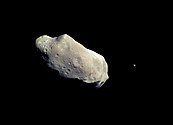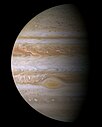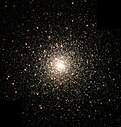천체
별, 행성, 달, 소행성 등의 총칭
천체(天體, 영어: celestial body, 독일어: Himmelischer Körper)는 우주에 존재하여 천문학의 연구 대상이 되는 것으로, 암석·기체·먼지 등 여러 물질이 중력에 의해 묶여 있는 상태로 존재하는 것과 그 집합을 가리켜 부르는 말이다.
| ||||||||
| 천체 및 물체의 선택 |

개설
편집천체의 대략적인 종류는 다음과 같다.
- 소행성: 항성 주위를 공전하지만, 그 질량이 행성 및 위성보다 작은 천체. (예:주노)
- 왜행성: 행성과 소행성의 중간 천체.
- 혜성: 태양 주위를 이심률이 큰 궤도를 그리면서 공전하는 천체. 태양 복사를 통해 핵에서 코마 및 꼬리가 생겨난다. 공전주기가 짧은 것은 몇년에서 몇십년이고, 긴 것은 수천 년에 이른다. (예:핼리 혜성)
- 위성: 행성 등의 주위를 도는 천체. 천체에서 다루는 위성은 자연위성을 뜻하며, 인간이 만든 인공위성은 포함되지 않는다. (예:달)
- 행성: 항성의 주위를 도는 천체.(예:지구)
- 항성: 태양과 같이 스스로의 핵융합을 통해 빛을 내는 천체이다. 별 속의, 고온 고압에 의한, 원자와 원자핵들의 핵융합에 의해 에너지를 얻고 빛을 낸다. 별빛을 통해서(더 정확히는 별빛 스펙트럼) 표면의 온도와 크기, 질량, 나이, 구성원소 등 별에 관한 거의 대부분의 정보를 얻는다. 행성에 비해 질량이 압도적으로 크다.(예:태양)
- 성운(Nebula): 성간매질과 수소로 이루어진 천체.
- 성단(Cluster): 중력으로 뭉쳐 있는 항성의 무리.
- 은하(Galaxy): 항성, 성간 물질, 플라즈마, 암흑 물질 등으로 이루어진 거대한 계.
우주 먼지 따위도 천체의 범주에 넣기도 한다.
영미권 용례
편집영미권의 천체는 1. Astronomical bodies, 2. Astronomical objects, 3. Celestial bodies, 4. Celestial objects의 네 가지 단어를 포함하는데 이들은 쓰임새에 차이가 있다.
상세 목록
편집| 태양계 | 태양계 외 천체들 | ||
|---|---|---|---|
| 단순 천체 | 조합 천체 | 확장 천체 | |
같이 보기
편집외부 링크
편집- 위키미디어 공용에 천체 관련 미디어 분류가 있습니다.
















